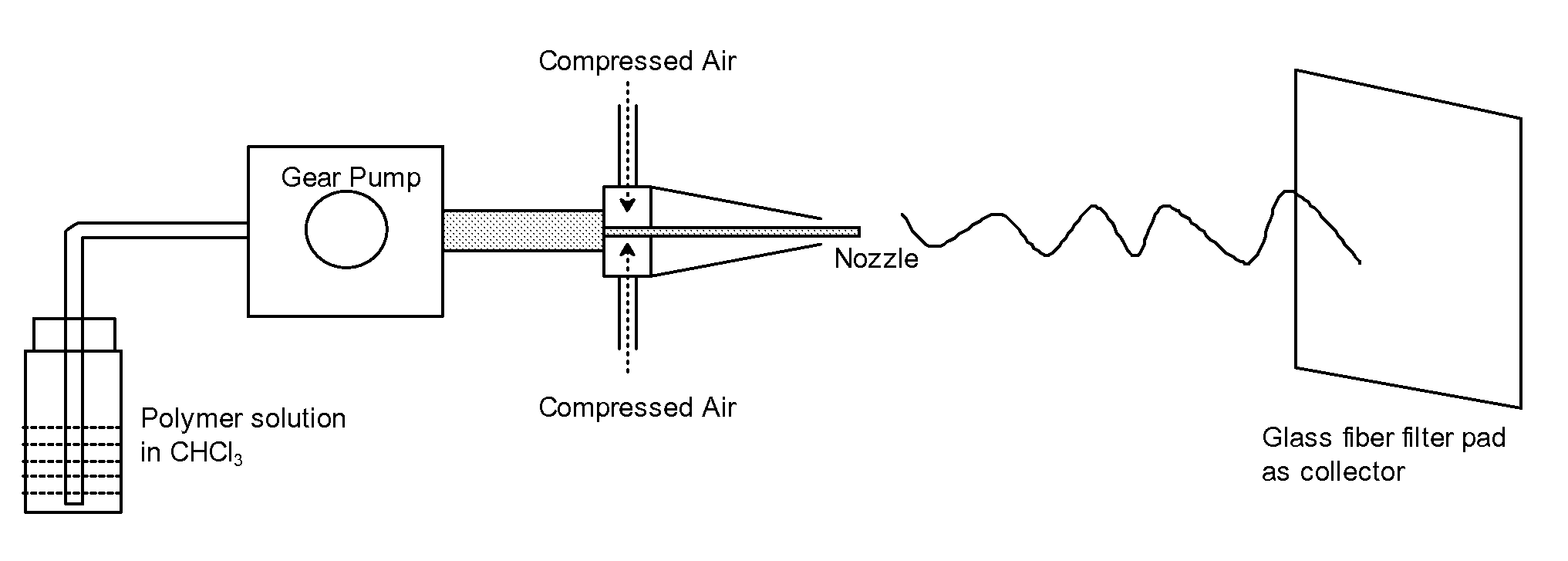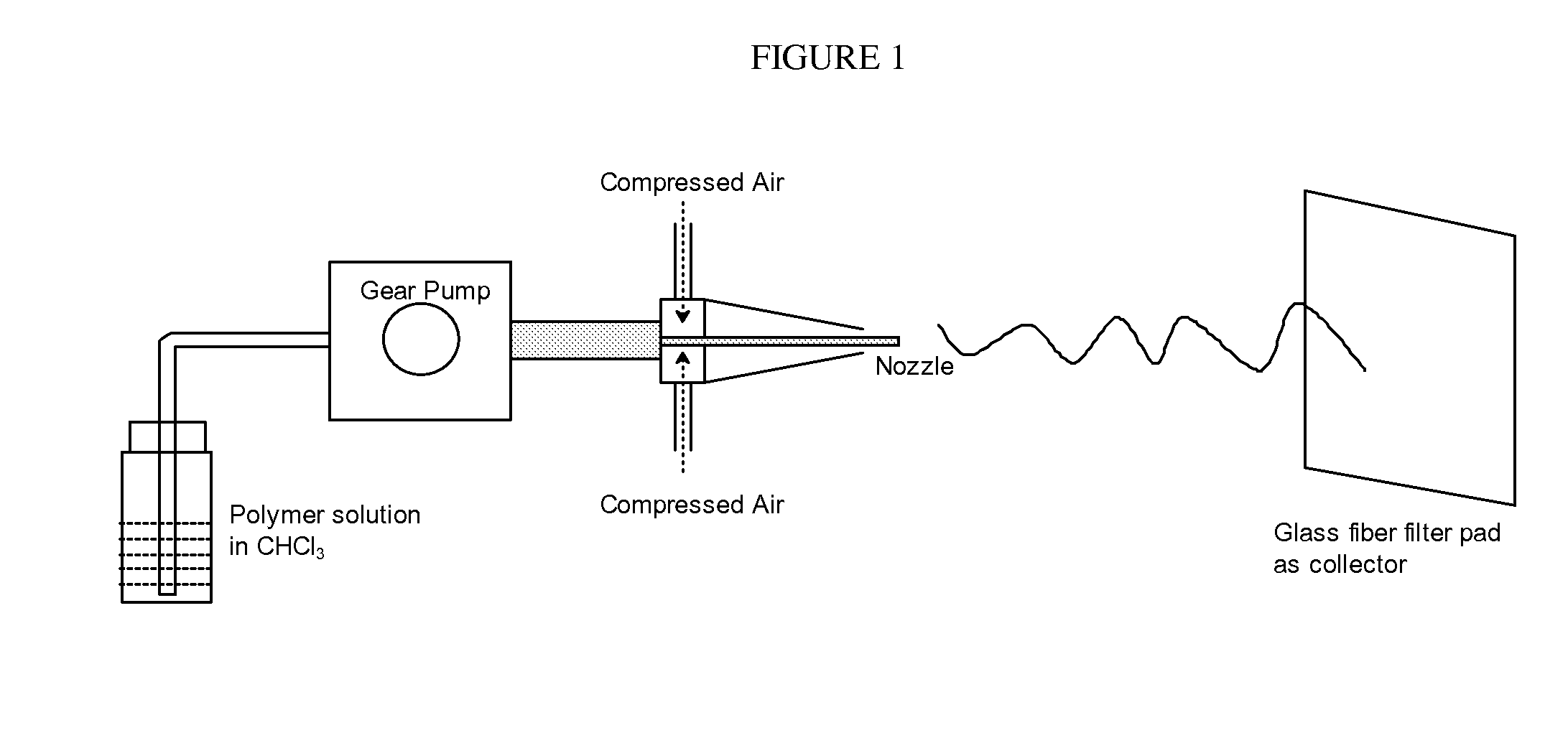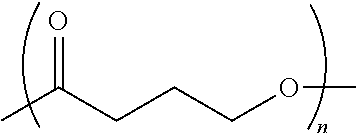Medical devices containing dry spun non-wovens of poly-4-hydroxybutyrate and copolymers
a technology of polyhydroxybutyrate and copolymer, which is applied in the field of polymer compositions to achieve the effects of high molecular weight, low modulus, and high toughness
- Summary
- Abstract
- Description
- Claims
- Application Information
AI Technical Summary
Benefits of technology
Problems solved by technology
Method used
Image
Examples
example 1
Preparation of P4HB Non-Woven by Dry Spinning
[0056]P4HB (Tepha, Inc., Lexington, Mass.) (M, 490 kDa) was dissolved in chloroform to make an 8% (wt / vol) polymer solution. P4HB dry spun non-woven was produced as described in method IIA above using the following conditions:
Solution flow rate: 3 mL / min
Distance between nozzle and collector: 32 inches
Needle: 0.035″ ID×0.375″ extrusion distance
Air pressure: 55 psi
Temperature: Ambient
[0057]Collection time: 6 minutes
[0058]The molecular weight Mw of the dry spun non-woven was determined by GPC relative to polystyrene, and found to be 474 kDa. Therefore the P4HB polymer lost a Mw of only 16 kDa (or approx. 3%) during processing into the dry spun non-woven.
[0059]Using methods similar to that described above the following dry spun non-wovens was prepared:
ReferenceAreal Density (g / m2)Burst Strength (Kgf)KG02-105-413.30.75
example 2
Preparation of a P4HB Non-Woven / Chitosan Patch by Dry Spinning
[0060]A similar procedure to that described in Example 1 was used to dry spin a P4HB non-woven directly onto a chitosan patch, except that the chitosan patch was placed in the collector position and the distance between the patch and the nozzle was adjusted to 30 inches. Collection times of 1, 2, 4, 6 and 8 minutes were used to make samples.
example 3
Comparison of Dry Spun and Melt Blown Non-Woven Molecular Weights
[0061]Several samples of P4HB melt-blown non-woven were prepared according to the procedure of Example 1 of WO 09 / 085,823 to Ho et al. using P4HB with a starting molecular weight (Mw) of 328 kDa. The molecular weight (Mw) of the resulting P4HB melt-blown non-wovens was found to be 207 to 157 kDa, representing a 47 to 52% decrease in the molecular weight (Mw) of the polymer during processing. This compares to a molecular weight (Mw) decrease of just 3% for the dry spun P4HB non-woven produced in Example 1. Thus it is apparent that for any given P4HB polymer resin, production of a non-woven by dry spinning will yield a much higher molecular weight fabric than by melt blowing.
PUM
| Property | Measurement | Unit |
|---|---|---|
| diameter | aaaaa | aaaaa |
| weight average molecular weight | aaaaa | aaaaa |
| weight average molecular weight | aaaaa | aaaaa |
Abstract
Description
Claims
Application Information
 Login to View More
Login to View More - R&D
- Intellectual Property
- Life Sciences
- Materials
- Tech Scout
- Unparalleled Data Quality
- Higher Quality Content
- 60% Fewer Hallucinations
Browse by: Latest US Patents, China's latest patents, Technical Efficacy Thesaurus, Application Domain, Technology Topic, Popular Technical Reports.
© 2025 PatSnap. All rights reserved.Legal|Privacy policy|Modern Slavery Act Transparency Statement|Sitemap|About US| Contact US: help@patsnap.com



